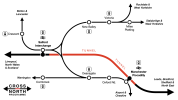GJMarshy
Member
Been quite a talking int over on SSC recently, thought you guys would have some valuable input on the mater. Assuming the conditional output for future East-West intercity services through Manchester is that they must travel via Piccadilly (which I'm well-versed is the condition) how do we go about this in a post-HS2 world where 2b (which was to be used for NPR) is highly unlikely to go ahead without HS2 attached, since the BCR won't stand a chance given the 400m station & speed specifications.
Upgrading castlefield seems to be out of the picture now, with 15/16 cancelled, and new/existing developments rendering 4-tracking near impossible, without closing the line for potentially multiple years, the economic disruption of that, and the cost of compulsory purchase orders in order to do it.
To me it seems something has to go into a tunnel, and that a simple point-point intercity bypass tunnel with a stop at Piccadilly makes the most sense, without needing to create swathes of grade-separated junctions which you'd need to funnel commuter/local services through it, which would use multiple lines.
So I put it to you guys, what's your preferred outcome, and what do you see as the likely outcome by say 2045?
Marshy.
Upgrading castlefield seems to be out of the picture now, with 15/16 cancelled, and new/existing developments rendering 4-tracking near impossible, without closing the line for potentially multiple years, the economic disruption of that, and the cost of compulsory purchase orders in order to do it.
To me it seems something has to go into a tunnel, and that a simple point-point intercity bypass tunnel with a stop at Piccadilly makes the most sense, without needing to create swathes of grade-separated junctions which you'd need to funnel commuter/local services through it, which would use multiple lines.
So I put it to you guys, what's your preferred outcome, and what do you see as the likely outcome by say 2045?
Marshy.

